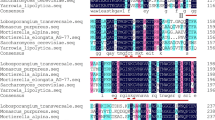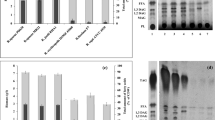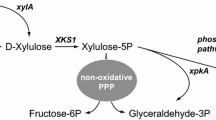Abstract
The glyoxylate cycle is an anabolic pathway that is necessary for growth on nonfermentable carbon sources such as vegetable oils and is important for riboflavin production by the filamentous fungus Ashbya gossypii. The aim of this study was to identify malate synthase in the glyoxylate cycle of A. gossypii and to investigate its importance in riboflavin production from rapeseed oil. The ACR268C gene was identified as the malate synthase gene that encoded functional malate synthase in the glyoxylate cycle. The ACR268C gene knockout mutant lost malate synthase activity, and its riboflavin production and oil consumption were 10- and 2-fold lower, respectively, than the values of the wild-type strain. In contrast, the ACR268C gene-overexpressing strain showed a 1.6-fold increase in the malate synthase activity and 1.7-fold higher riboflavin production than the control strain. These results demonstrate that the malate synthase in the glyoxylate cycle has an important role not only in riboflavin production but also in oil consumption.








Similar content being viewed by others
References
Demain AL (1972) Riboflavin oversynthesis. Annu Rev Microbiol 26:369–388
Dietrich FS, Voegeli S, Brachat S, Lerch A, Gates K, Steiner S, Mohr C, Pohlmann R, Luedi P, Choi S, Wing RA, Flavier A, Gaffney TD, Philippsen P (2004) The Ashbya gossypii genome as a tool for mapping the ancient Saccharomyces cerevisiae genome. Science 304:304–307
Dixon GH, Kornberg HL (1959) Assay methods form key enzymes of the glyoxylate cycle. Biochem J 72:3
Fernandez E, Moreno F, Rodicio R (1992) The ICL1 gene from Saccharomyces cerevisiae. Eur J Biochem 204:983–990
Gould SJ, Keller GA, Subramani S (1988) Identification of peroxisomal targeting signals located at the carboxy terminus of four peroxisomal targeting signal. J Cell Biol 107:897–905
Hartig A, Simon MM, Schuster T, Daugherty JR, Yoo HS, Cooper TG (1992) Differentially regulated malate synthase genes participate in carbon and nitrogen metabolism of S. cerevisiae. Nucleic Acids Res 20:5677–5686
Hemida L, Brachat S, Voegeli S, Philippsen P, Primig M (2005) The Ashbya Genome Database (AGD)—a tool for the yeast community and genome biologists. Nucleic Acids Res 33:D348–D352 (Database issue)
Jiménez A, Davies J (1980) Expression of a transposable antibiotic resistance element in Saccharomyces. Nature 287(5785):869–871
Jiménez A, Santos MA, Pompejus M, Revuelta JL (2005) Metabolic engineering of the purine pathway for riboflavin production in Ashbya gossypii. Appl Environ Microbiol 71(10):5743–5751
Jiménez A, Santos MA, Revuelta JL (2008) Phosphoribosyl pyrophosphate synthetase activity affects growth and riboflavin production in Ashbya gossypii. BMC Biotechnol 8:67–78
Kanamasa S, Tajima S, Park EY (2007) Isocitrate dehydrogenase and isocitrate lyase are essential enzymes for riboflavin production in Ashbya gossypii. Biotechnol Bioprocess Eng 12:92–99
Kato T, Park EY (2004) Expression of alanine:glyoxylate aminotransferase gene from Saccharomyces cerevisiae in Ashbya gossypii. Appl Microbiol Biotechnol 71:46–52
Kornberg HL, Madsen NB (1957) Synthesis of C4-dicarboxylic acids from acetate by a “glyoxylate bypass” of the tricarboxylic acid cycle. Biochim Biophys Acta 24:651–653
Kunze M, Kragler F, Binder M, Hartig A, Gurvitz A (2002) Targeting of malate synthase 1 to the peroxisomes of Saccharomyces cerevisiae cells depends on growth on oleic acid medium. Eur J Biochem 269:915–922
Larkin MA, Blackshields G, Brown NP, Chenna R, McGettiqan PA, McWilliam H, Valentin F, Wallace IM, Wilm A, Lopez R, Thompson JD, Gibson TJ, Hiqqins DG (2007) ClustalW and Clustal X version 2.0. Bioinformatics 23:2947–2948
Lorenz MC, Fink GR (2001) The glyoxylate cycle is required for fungal virulence. Nature 412:83–86
Maeting I, Schmidt G, Sahm H, Revuelta JL, Stierhof YD, Stahmann KP (1999) Isocitrate lyase of Ashbya gossypii—transcriptional regulation and peroxisomal localization. FEBS Lett 444:15–21
Monschau N, Sahm H, Stahmann KP (1998) Threonine aldolase overexpression plus threonine supplementation enhanced riboflavin production in Ashbya gossypii. Appl Environ Microbiol 64(11):4283–4290
Park EY, Ming H (2004) Oxidation of rapeseed oil in waste activated bleaching earth and its effect on riboflavin production in culture of Ashbya gossypii. J Biosci Bioeng 97(1):59–64
Park EY, Zhang JH, Tajima S, Dwiarti L (2007) Isolation of Ashbya gossypii mutant for an improved riboflavin production targeting for biorefinery technology. J Appl Microbiol 103:468–476
Sambrook J, Russell DW (2001) Molecular cloning: a laboratory manual, 3rd edn. Cold Spring Harbor Laboratory Press, New York
Schmidt G, Stahmann KP, Kaesler B, Sahm H (1996a) Correlation of isocitrate lyase activity and riboflavin formation in the riboflavin overproducer Ashbya gossypii. Microbiology 142:419–426
Schmidt G, Stahmann KP, Sahm H (1996b) Inhibition of purified isocitrate lyase identified itaconate and oxalate as potential antimetabolites for the riboflavin overproducer Ashbya gossypii. Microbiology 142:411–417
Schmitt MR, Edwards GE (1983) Provisions of reductant for the hydroxypyruvate to glycerate conversion in leaf peroxisomes: a critical evaluation of the proposed malate/aspartate shuttle. Plant Physiol 72:728–734
Stahmann KP, Böddecker T, Sahm H (1997) Regulation and properties of a fungal lipase showing interfacial inactivation by gas bubbles, or droplets of lipid or fatty acid. Eur J Biochem 244:220–225
Stahmann KP, Revuelta JL, Seulberger H (2000) Three biotechnical processes using Ashbya gossypii, Candida famata, or Bacillus subtilis compete with chemical riboflavin production. Appl Microbiol Biotechnol 53:509–516
Wendland J, Ayad-Durieux Y, Knechtle P, Rebischung C, Philippsen P (2000) PCR-based gene targeting in the filamentous fungus Ashbya gossypii. Gene 242:381–391
Wright MC, Philippsen P (1991) Replicative transformation of the filamentous fungus Ashbya gossypii with plasmids containing Saccharomyces cerevisiae ARS elements. Gene 109(1):99–105
Acknowledgment
This study was supported by the Comprehensive Support Programs for Creation of Regional Innovation in Japan Science and Technology Agency.
Author information
Authors and Affiliations
Corresponding author
Rights and permissions
About this article
Cite this article
Sugimoto, T., Kanamasa, S., Kato, T. et al. Importance of malate synthase in the glyoxylate cycle of Ashbya gossypii for the efficient production of riboflavin. Appl Microbiol Biotechnol 83, 529–539 (2009). https://doi.org/10.1007/s00253-009-1972-1
Received:
Revised:
Accepted:
Published:
Issue Date:
DOI: https://doi.org/10.1007/s00253-009-1972-1




